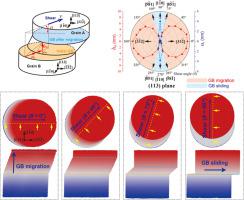International Journal of Plasticity ( IF 9.8 ) Pub Date : 2022-06-30 , DOI: 10.1016/j.ijplas.2022.103370 Anping Hua , Junhua Zhao

|
Control over grain boundary (GB) motion ways provides an effective mean for tailoring the mechanical and physical properties of nanocrystalline metals. However, shear direction induced transition from GB migration to sliding in nanocrystalline metals has remained elusive. In this work, we used molecular dynamics (MD) simulations to track the dynamic process of a representative Σ11(113) high-angle GB in a cylindrical copper bicrystal under controllable shear directions parallel to the GB plane. When the shear direction changed from the [33] direction to the [10] direction (the shear angle θ increased from 0° to 90°), the dominant GB deformation mechanism switched from GB migration to sliding. The critical orientation (critical shear angle) of the transition was [8] (75°). Atomistic observations indicated that the disconnection and the surface step nucleation provoked the GB migration and sliding, respectively. This shear direction induced transition was also found in other 〈110〉 symmetrical and asymmetric tilt GBs, as well as nano polycrystalline metals. Analytical models revealed that the transition mechanism originated from the competition between the nucleation energies of the disconnection and surface step. These insights may contribute to the ongoing search for favoring manageable design of nanocrystalline metals by GB-mediated plastic deformation.
中文翻译:

圆柱形铜双晶中从晶界迁移到滑动的剪切方向诱导转变机制
对晶界 (GB) 运动方式的控制为调整纳米晶金属的机械和物理性能提供了有效的手段。然而,剪切方向诱导的从 GB 迁移到纳米晶金属滑动的转变仍然难以捉摸。在这项工作中,我们使用分子动力学 (MD) 模拟来跟踪具有代表性的 Σ11(113) 高角 GB 在平行于 GB 平面的可控剪切方向下在圆柱形铜双晶中的动态过程。当剪切方向从 [33] 方向到 [10]方向(剪切角θ从0°增加到90°),主要的GB变形机制从GB迁移转变为滑动。过渡的临界方向(临界剪切角)为 [8] (75°)。原子观察表明,断开和表面台阶形核分别引发了 GB 迁移和滑动。在其他<110>对称和不对称倾斜GB以及纳米多晶金属中也发现了这种剪切方向诱导的转变。分析模型表明,转变机制源于断开和表面步骤的成核能量之间的竞争。这些见解可能有助于通过 GB 介导的塑性变形来寻找有利于纳米晶金属的可管理设计。



























 京公网安备 11010802027423号
京公网安备 11010802027423号